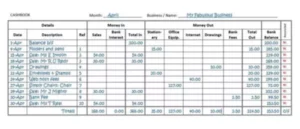Content

Many restaurant owners struggle to weigh the benefits against the cost. Most robust payroll software comes with plenty of features that can help you take care of your taxes easily and accurately. It’s good practice to ensure your payroll software can take care of both employee tax filing and 1099-MISC if you plan on working with contractors or have a seasonal business. SurePayroll offers inexpensive online payroll software, including year-end reporting, automatic tax filing and payments, and the option to handle tax filings yourself.

The difference between the tipped wage paid to your employees and the federal minimum wage is considered a tip credit. Running payroll for the first time is always challenging, but running restaurant payroll can be particularly challenging. In fact, even experienced restaurant owners often struggle with restaurant payroll management. Justworks is an HRIS and PEO that includes a payroll platform with employee self-service. As a PEO, it offers robust HR support and acts as an employer of record for your employees to take some of the administration work off your plate.
Calculate Restaurant Payroll Properly
Once you’ve got your restaurant payroll process set up and ready to go, it’s time to start crunching the numbers. Regardless of the process you choose, you’ll need to keep a record of tips received so you can produce an accurate restaurant payroll. For a more-detailed look at the process, check out our free guide on mastering restaurant payroll.
However, it doesn’t cater to varying business needs with multiple plan tiers. Here are 8 top software options selected for payroll and account management assistance in the restaurant business. Your payroll needs will vary depending on your business’s size, the benefits you intend to offer, and any specific integrations you might need. If you are already using a point of sale system or payment processing service such as Square or Toast, its payroll option may be the most conducive and cost-efficient for your business. For a basic, starting payroll program, SurePayroll does a lot of things well.
Non-cash tips
If the company is small, a CPA or other professional firm might cost anywhere from $2,500-$5,000 depending on complexity (losses, employees working in more than one state, etc). For a larger company such as a restaurant with 10+ employees there may be an additional charge for taxes like unemployment insurance and workers’ comp if applicable. However, after deducting federal, state, local, and FICA taxes from their paycheck, they go home with $732. Understanding the ins and outs of paying employees, observing labor laws, and complying with the tax code is critical to running a business. With Sling, you’ll have unprecedented command of your employee scheduling so you can then fully control your restaurant payroll and keep your business in the black.
It’s ideal if your business is in a rapid growth phase, as it offers easy, scalable, and flexible plans to accommodate your growing payroll processing requirements. Paychex Flex is cloud-based payroll software that grows https://www.bookstime.com/ as your business does. It’s designed to help small enterprises manage payroll and HR processes, employee benefits, and more. QuickBooks is generally user-friendly, but you’ll need basic knowledge of running payroll.
Step 3: Distribute tips earned
Form 940 is a payroll report submitted annually that indicates federal unemployment tax (FUTA) paid during the year. Federal unemployment tax does not come out of your employees’ paychecks but is paid directly by your business. The federal level is where you’ll find the bulk of the quarterly and annual restaurant payroll reports.
To find an employee’s net pay, simply subtract all withholdings, garnishments, federal, state, and local income taxes, and federal Social Security and Medicare taxes from the total gross pay. First, did the employee perform multiple roles that have different pay rates? If so, rates, amounts, hours worked, etc. for all the employee’s roles need to be included when calculating gross pay. The forms your restaurant employees complete when they are hired, the amount of tips they report and the records for every pay period should all be stored.
Law of Diminishing Marginal Returns in Restaurant Operation
In this case, Kim works as a hostess for $15 an hour (the standard rate for a host/hostess in your restaurant) and accrues 40 hours during a single week. However, another hostess calls in sick, so Kim covers her shifts and works a total of 50 hours in one week. However you choose to do it, this is the last step of your restaurant payroll.
Some payroll software will even go as far as automatically filing your taxes for you. This is an extremely useful feature if your restaurant is in its early stages and can’t quite afford an in-house accountant. It can also be a way to avoid paying additional service fees for outside accounting services. This software can ensure you’re paying your employees payroll for restaurants accurately and on time each month—and some are even free. ADP RUN is a cloud-based payroll and HR system to support restaurant managers in processing payroll, taxes, basic hiring and onboarding, job postings, and more. It provides expert HR support for professional services to help you better manage your staff and navigate complicated HR issues.
Two Jobs At Two Pay Rates
It also has built-in HR and the ability for employees to onboard themselves for an affordable price. With each employee’s gross pay established, owners then need to confirm if their tipped employees’ paychecks will fulfill the minimum wage threshold for that state. Again, if a tipped employee’s combined base wage and tips do not meet the state’s minimum wage amount, the employer must make up the difference. As you can see based on the amount of paperwork involved (and that’s just the tip of the iceberg), the complexities of restaurant payroll and compliance create a substantial risk for costly errors. Back Office works with every payroll client to ensure compliancy, accuracy, and timeliness of payments. Our clients receive direct guidance on properly recording wages while paying employees in compliance with local, state, and federal law.
In most states and federally, employers pay unemployment taxes themselves but split the payment of Social Security and Medicare taxes with employees. So, for example, imagine your tipped employee makes $1 per hour in tips. In order to bring their total earnings to the federal minimum wage of $7.25 per hour, you’ll need to pay them at least $6.25 per hour. Check the regulations and minimum wage laws set forth in the Fair Labor Standards Act. Unless they are exempt, employees who are covered by the FLSA must be paid overtime for the hours they worked over 40 in a workweek – at a rate of no less than time and a half their regular pay.
